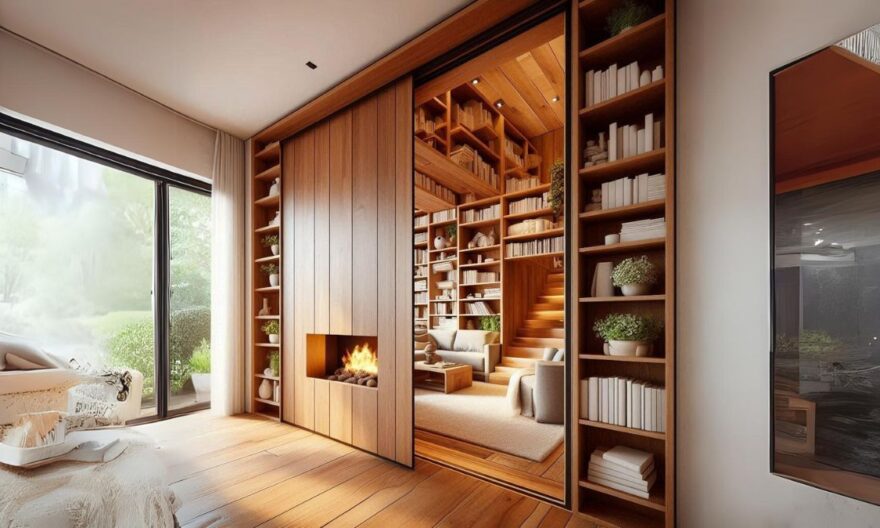
Slide and hide doors have become very famous in interior design. Not only are they sleek and fashionable as compared to conventional doors, but they also offer a wonderful way of maximising space by avoiding a boundary among rooms. If you’re considering fitting sliding doors in your home, especially in space-constrained Singapore, you’ll need to choose the right materials, colours, and finishes. These can further influence both the functionality and aesthetic appeal of your sliding pocket door.
This guide talks about the various customization options available to create the perfect slide and hide door for any modern interior.
Why Choose Slide and Hide Doors?
- Space Efficiency: Very little swing space is needed by slide and hide doors, so they work great for small apartments or just small rooms.
- Modern Aesthetics: It brings about a modern feel to the interior and thus goes well with ultramodern interiors.
- Versatility: These doors can be used in various places, like in bedrooms, bathrooms, closets, or even as room dividers.
- Privacy and Accessibility: They provide privacy where necessary but give ease of access from one room to another.
Materials: The Makeup of Your Door’s Look and Feel
Firstly, the material used to make your slide and hide door will largely determine its look, strength, weight, and soundproofing qualities. Therefore, it’s important to consider some popular materials used in crafting these doors, such as:
1. Wood
- Pros: It is traditional and adds warmth and class to a room. Wood types are available in oak, walnut, and cherry, each wood type having different grain patterns.
- Cons: Wood can be heavy and so may need a more robust track system; it may also require regular maintenance to avoid warping or water damage.
- Best For: Traditional or rustic interiors where warmth and natural texture are desirable.
2. Glass
- Pros: Glass slide and hide doors give a feeling of openness and can make small spaces feel larger. They come in clear, frosted, or tinted versions.
- Cons: The glass door, no matter how aesthetically handsome it is, shows what is on the other side and is quite difficult to clean.
- Best For: Modern, minimalist interiors where light flows freely and space needs to be opened up.
3. Metal
- Pros: Metal doors, typically fabricated from aluminium or steel, give a sleek and industrial look. They are very robust, hard-wearing, and require very little in the way of maintenance.
- Cons: If it is not counterbalanced by more warm elements inside a room, metal can be very cold and impersonal.
- Best For: Industrial or contemporary interiors where a clean, modern look is desired.
4. Composite Materials
- Pros: Composite doors combine top features from other materials, offering strength and easy care plus the choice of many finishes.
- Cons: They sometimes lack the genuine, natural appeal that is inherent in pure wood or glass doors.
- Best For Homes desiring that mix of durability and cost with looks.
Colours: Setting the Mood and Style
Colour plays a huge role in how your sliding door in Singapore is going to provide contrast or blend with other interiors. Here are some things to consider while customising your slide and hide doors:
1. Neutral Tones
- Benefits: Shades like white, beige, and grey are timeless and versatile. Specifically, they effortlessly complement any interior style, thus providing a clean and cohesive look in homes.
- Use For: Modern and minimalist interiors where you want the door to blend into its surroundings.
2. Bold Colours
- Benefits: A bold colour like deep blue, rich green, or even black can really make your sliding door in Singapore pop.
- Use For: Contemporary or eclectic interiors where the door will come to serve as a focal point.
3. Wood Stains
- Benefits: If you opt for a wood door, notably, natural wood stains highlight the grain and add warmth to the space. Indeed, from light oak to rich dark walnut, the stain you pick significantly alters the overall look and feel of your door.
- Use For: Traditional or rustic interiors in which the beauty of wood should be highlighted at its most natural state.
4. Custom Colours
- Benefits: Custom colour options to make them truly unique and perfectly match or contrast with your sliding door and interior palette.
- Use For: Every single detail is personal in a personalised interior, making it your own.
Finishes: The Final Touch
The finish of your slide and hide door is what you will be touching every day, so it really is part and parcel of the customization process. Here are some finishes you should consider:
1. Matte Finish
- Pros: A flat, matte finish creates a soft, subtle appearance perfect for modern interiors; it hides fingerprints and smudges very well.
- Cons: Matte finishes are more prone to scuff marks.
- Best For: Modern interiors where subtle, non-reflective finishes are desired.
2. Glossy Finish
- Pros: The glossy finish will reflect light and give the space the illusion of larger square footage and brightness, adding a feel of elegance while being easy to clean.
- Cons: More easily shows fingerprints, and scratches on glossy surfaces
- Best For: Contemporary or glam interiors that require shine and light reflection
3. Textured Finish
- Pros: These add depth and interest to a door through the look of brushed metal or distressed wood. Besides, they can hide imperfections better than smooth finishes can.
- Cons: Some textures may become a bit difficult to clean and maintain.
- Best For: Industrial, rustic, or eclectic interiors where texture is used to add character.
4. Custom Finishes
- Pros: If you’re looking for a special effect, the many types of custom finishes available give you the ability to personalise your door with exactly the effect you want, such as unusual paint effects or intricately carved wood.
- Cons: Custom finishes are almost always more costly and often involve a longer lead time.
- Best For: Personalised interiors where every element carries significant weight.
Mixing Materials, Colors, and Finishes
Once you’ve chosen the material, colour, and finish for your slide and hide door, it’s time to consider how these parts fit together. Check out these useful tips:
- Coordinate with existing elements: Ensure the design of the door matches the existing furniture you have, the flooring, and the colour of the walls. For example, a naturally stained wooden door blends well with hardwood floors and walls painted in a neutral colour.
- Balance bold choices: If you’ve opted for a bold colour or a textured finish, then balance it with the surroundings that are more subdued to keep from making the space seem cluttered.
- Mix and match: Don’t fear combinations of different materials or finishes. For instance, a glass door in a wooden frame concurrently offers transparency and warmth.
- Consider functionality: some materials and finishes are best suited to particular rooms. For example, a glossy finish may work well in a kitchen door, while a matte kind of finish may work well in a bedroom.
Conclusion
Firstly, you can tailor-make your slide and hide doors as desired, thus creating an opportunity to enhance both style and functionality. Moreover, this is achieved through a thoughtful selection of materials, colours, and finishes, resulting in a door that’s not only practical but also aligned with your preferences. Additionally, from contemporary aesthetics to classic tones, the possibilities are endless. Furthermore, when making your choices, consider how each component will blend to create a unified, balanced design. Ultimately, with appropriate customization, your sliding pocket door for a modern interior can become the centrepiece of your house.
Also Read: Sleek and Stylish: Contemporary Design Trends in Aluminium Glass Doors

